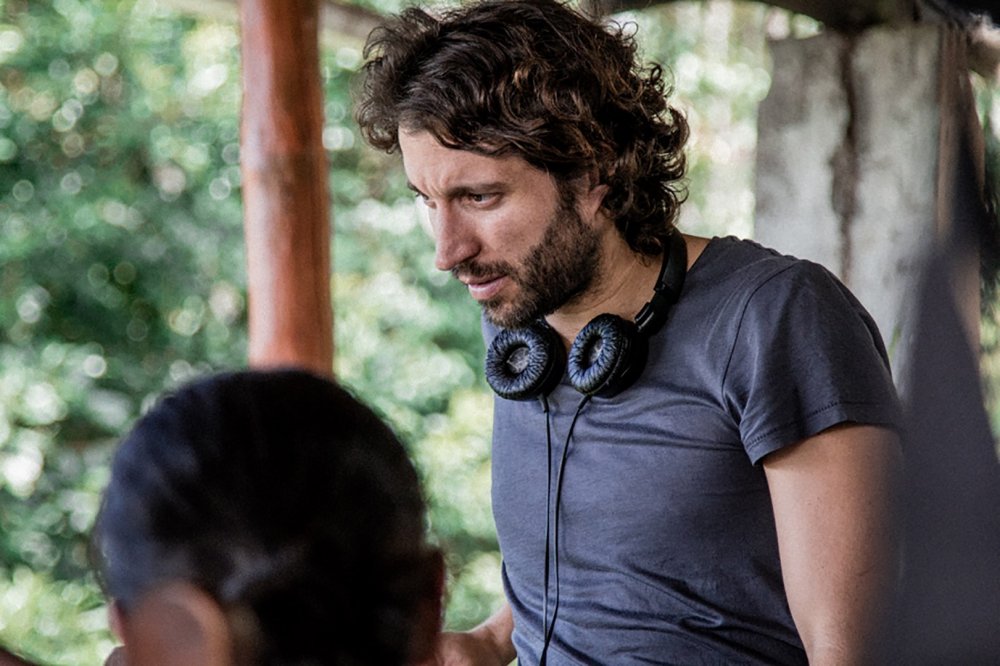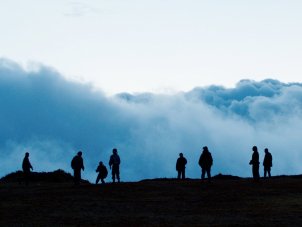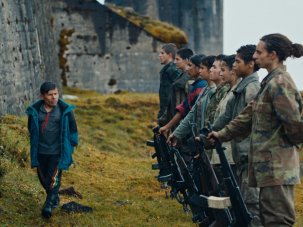“Show me your war face!” barks a commander at the start of Colombian-Ecuadorian director Alejandro Landes’s survival thriller Monos. In front of him on an unnamed remote mountaintop are eight guerrillas, ranging from barely teenage to young adults. Their DIY khaki uniforms may be muddy and makeshift but their rifles and military drills are polished. By day they play at war and make proof-of-life videos with their American hostage – a woman identified only as ‘Doctora’, played by Julianne Nicholson. When the commander, known only as the Messenger, departs, something resembling regular teen life, albeit cut through with violence, resumes at the boot camp in the clouds. By night, the squadron parties in the glow of the campfire.
Monos is released in UK cinemas on 25 October.
“We’ve all had that dream as kids, right?” Landes says, talking to me on the phone from Los Angeles, where he has just closed a deal to finance his next film. “To be free, surrounded by people your own age on top of a mountain and at first it seems like there is no one to tell you what to do.” Apocalypse Now (1979) and Werner Herzog’s doomed Amazonian adventures (Aguirre, Wrath of God, 1972; and Fitzcarraldo, 1982) have been the references critics have boxed Monos into so far. But while Landes tracks the descent of his band of guerrillas into hallucinatory chaos amid the rainforest, we’re never allowed to forget that what we are witnessing is war through teenage eyes.
Savage youth
“There have been a lot of films about child soldiers and they tend to trade on pity. I didn’t want that,” Landes says. “We already know that children don’t have a place in war. I don’t think I need to take four years of my life to tell that tired story. The idea was to take it further. Let’s see the dynamics between teenagers that you see in the schoolyard. A lot of child soldiers weren’t recruited by force. They saw joining a rebel army as a better life or they believed in the cause.”
Here, though, there is no obvious cause: we are simply ambushed by a savage Neverland. Landes drops us into the feral world of the squad, collectively called monos (Spanish for ‘monkeys’, but the prefix ‘mono’ also has, Landes notes, connotations of aloneness). He gives little away about the teen commandos beyond their childish nicknames: Smurf, Rambo, Bigfoot, Wolf, Boom Boom. For these kids violence is a fact of life, embedded by their own code of conduct, which decrees everyone should receive a happy-birthday beating, and by the draconian military protocol that dictates death for any member of the squad who transgresses.
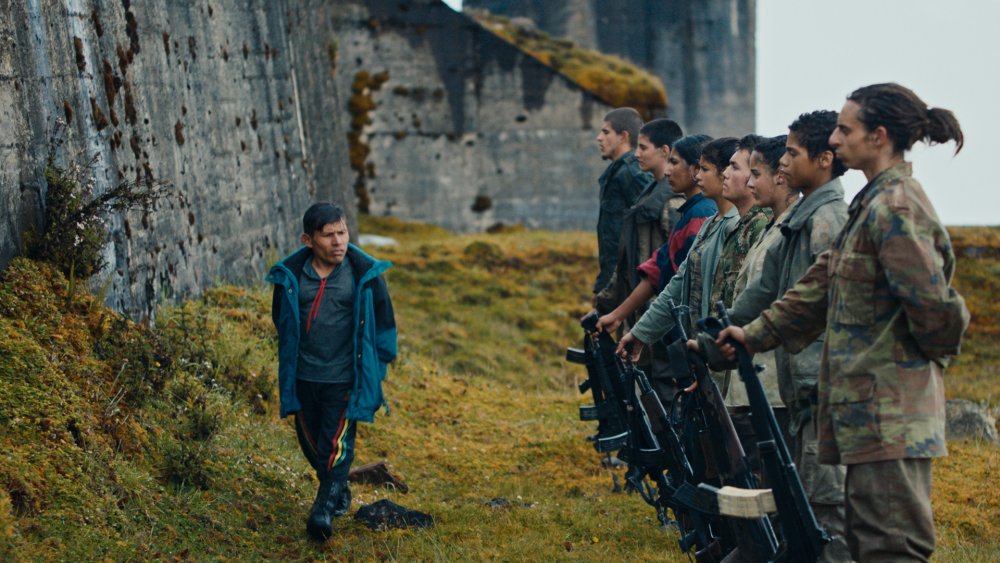
Monos (2019)
Two films that zero in on the highly subjective experience of young and isolated rebel armies stand out as closer analogies than either Coppola or Herzog – Jean- Stéphane Sauvaire’s brutal examination of child soldiers in Liberia, Johnny Mad Dog (2008), and Wakamatsu Koji’s account of real-life 1960s Japanese students in a paramilitary mountain training camp, United Red Army (2007). But both of those filmmakers told their stories vérité-doc style. What’s unique about Landes’s film is its mix of surrealism and hyperrealism: it feels like a post-apocalyptic fable. Shooting in wide-frame CinemaScope, cinematographer Jasper Wolf captures the epic and remote nature of life at altitude, where a pink flare from a faraway conflict can burst through and light up the dusky cloudscape. He pays equal attention to the harsh everyday reality of the sodden camp with fog-framed shots and an endless palette of sludgy greens. Meanwhile, Mica Levi’s score, an anxiety-inducing haze of whistles, drums and animal sounds, completes the immersive sensorial experience.
While Lord of the Flies is clearly an influence – signposted perhaps a little too eagerly by the appearance of a pig’s head on a stick – Elem Klimov’s Come and See (1985), which depicts a 14-year-old’s view of World War II in Belarus, also looms large: Landes wanted to recreate that film’s waking-dream nature. The photographer Nan Goldin’s intimate portraits of her family and friends were also among the director’s visual references: “I responded to the way she shoots exposed bodies and flesh. This is a film that leads more with the skin and stomach than it does with the head.”
The fog of war
In the film Landes refuses to reveal the political ideology of the kids or the organisation they report to, and the film’s setting is equally opaque, though he admits that the starting point was the Colombian ‘conflict’: “It was a shadow war, a war without a frontline during which factions and alignments changed.” His view is that this kind of warfare is now prevalent: “It’s fresh for our generation that most wars are being fought by covert operations. In America if you ask someone on the street what side they are on in Syria, they don’t know. Watching a war film with a frontline and flags, you have more clarity about where you stand.” Landes wanted the opposite. “People are attracted to making films about World War II because there seems to be a very clear moral line as to who’s good and who’s bad. In war today, particularly from the back line, there’s a lot more moral ambiguity to explore.”
Ambiguity is rife throughout the film and for Landes, this not only reflects the experience of war now but allows the audience to identify more closely with the characters: “You don’t know if you’re in the future or the past, if the characters’ ideologies are on the left or the right. Sometimes the gender of the characters is not clear. What I liked about that is that it forces you to leave your prejudices at the door.”
Colombia is only now experiencing a fragile peace after more than 50 years of conflict. “The peace agreement calls for guerrillas to lay down arms and return to civilian life, but will they be accepted?” Landes wonders. “People feel more comfortable if they have all the information in front of them. No, thank you. Here you can’t latch on to the things we generally use to judge people. I really wanted to parachute the audience into the situation so they couldn’t come into it through the ideology. If you knew that the kidnapped woman was a CIA operative, you might be less sympathetic to her, or if she was an NGO worker you might be more.”
Provoking a sense of discomfort through the style of the film was also important to him: “The kids have such fresh faces and give such natural performances but then they regularly break the fourth wall. I wanted to juxtapose a high degree of stylisation with realism so the film doesn’t allow you to classify it.”
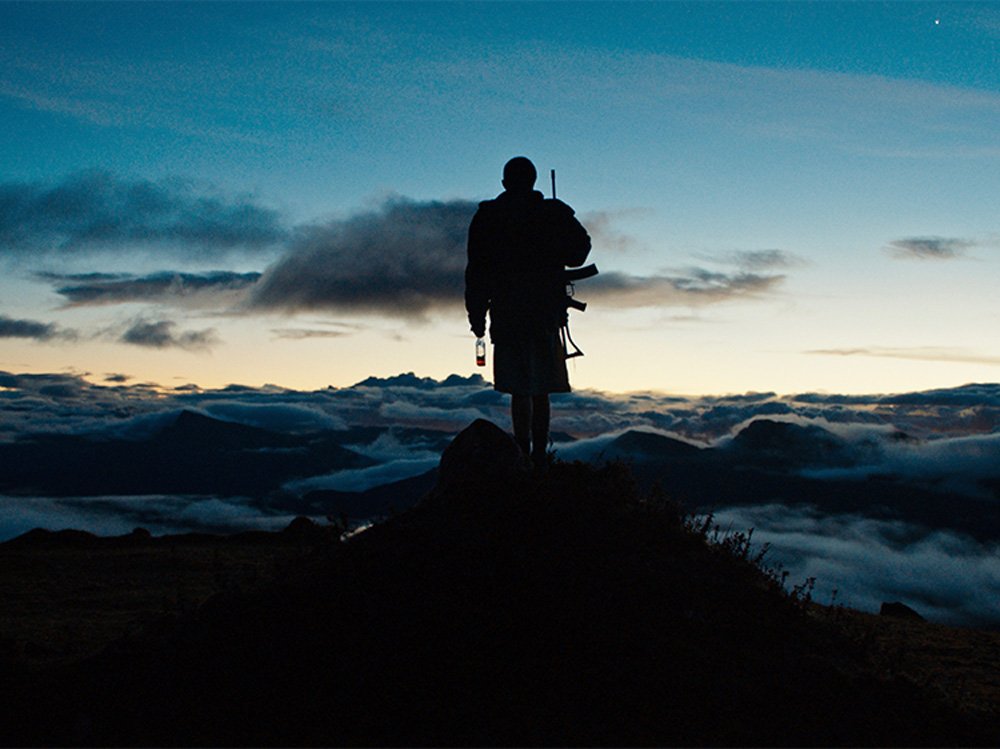
Monos (2019)
Guerrillas in the mist
Landes’s first film was a documentary: Cocalero (2007), about Bolivia’s first indigenous president, Evo Morales. His second, Porfirio (2011), was a highly sensual docufiction portrait of a paralysed man. Despite its surreal leanings, Monos is, like those films, very much grounded in fact: “I read many accounts of politicians and NGO workers that had been kidnapped and their day-to-day guards were kids. Even in the case of Ingrid Betancourt Pulecio, a very high-profile Colombian politician who was kidnapped, she was taken care of by kids for a few days. The cheapest way for rebel armies to take care of their hostages was to give them to those on the lowest rung of the ladder.”
Landes also spent a lot of time in reintegration programmes designed to help former guerrillas prepare for a return to civilian life. That is where he encountered Wilson Salazar, who had joined a rebel army at the age of 11, rising to its most senior ranks before deserting when he was 24. He became the film’s military adviser before Landes convinced him to play the Messenger.
To recruit the monos, 25 Colombian kids, from a pool of 800, were chosen to take part in a five-week training camp high in the Andes. There, as well as doing improv acting exercises, they received idiosyncratic military training (waking at 4am to strange calls, carrying weapons in unusual ways). With the exception of Moisés Arias, who plays Big Foot, no one had professional acting experience. Landes observed them performing both individually and as a squad before making his selection. “It was important for me to see the chemistry between them but also get to know them. How else do you get a raw emotional performance from a 17-year-old kid like Deiby Rueda, who plays Smurf, and who comes from one of the toughest neighbourhoods in Medellín, and who isn’t used to showing any type of vulnerability?”
Jungle fever
“I never wanted landscape shots without characters in them. I was very firm about the landscapes never looking like postcards,” Landes explains. “They had to mirror the interior state of the characters. When you see the monos in the mountains there’s a very clear sense of scale. As otherworldly as the scenes are, the characters look small and there’s still a sense of innocence and promise to them. When you start going into the canopy of the jungle, the sense of scale gets lost and the group starts fragmenting, so the landscape is part of the narrative arc.”
Shooting in such remote locations (which were until recently inaccessible because of the fighting between guerrillas and paramilitaries) came with a range of challenges; plans to shoot on 35mm were abandoned as too complicated. The forms of transport the cast and crew took say it all: helicopter, mule, kayak and raft – and later, a stretcher and ambulance when Landes had to be rushed out of the jungle with suspected appendicitis. Their only form of communication with the outside world was a satellite phone they couldn’t use because it was too expensive.
“I had intense discussions with all the crew: we’d storyboarded and had a shot list, but when you’re 4,000 metres up a mountain or deep in the jungle, you sometimes just have to take advantage of what’s actually happening in front of you.”
-
The 100 Greatest Films of All Time 2012
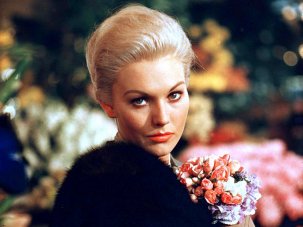
In our biggest ever film critics’ poll, the list of best movies ever made has a new top film, ending the 50-year reign of Citizen Kane.
Wednesday 1 August 2012
-
The Digital Edition and Archive quick link
Log in here to your digital edition and archive subscription, take a look at the packages on offer and buy a subscription.




